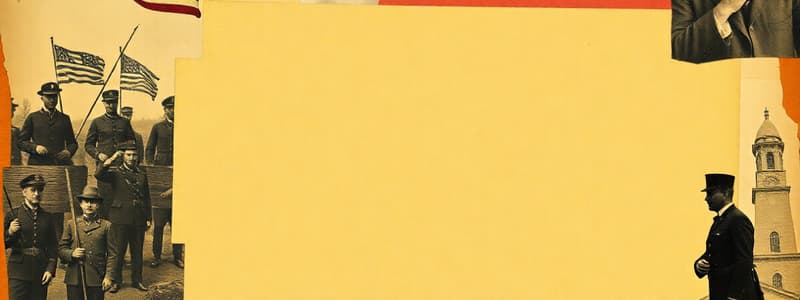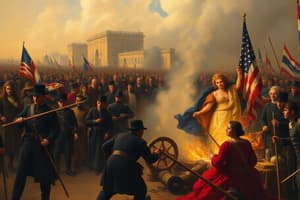Podcast
Questions and Answers
What was a key difference in the visions for reconstruction between President Andrew Johnson and the Republican party?
What was a key difference in the visions for reconstruction between President Andrew Johnson and the Republican party?
- Johnson sought to punish former Confederate leaders harshly, while Republicans advocated for leniency.
- Republicans supported limiting the power of the federal government, while Johnson advocated for federal control.
- Republicans believed in the continued practice of slavery in Southern state, while Johnson sought to free them all.
- Johnson aimed for a swift return to the pre-war status quo, while Republicans sought more significant societal change. (correct)
Which of the following best describes the initial impact of the Emancipation Proclamation?
Which of the following best describes the initial impact of the Emancipation Proclamation?
- It immediately freed all enslaved people throughout the United States.
- It had a symbolic effect but caused a major shift in military strategies.
- It was immediately recognized as US federal law and became the law of the land.
- It only applied to enslaved people in Confederate-held territory during the Civil War and created opportunities for escape. (correct)
What was the primary loophole in the 13th Amendment, as it was ratified in 1865?
What was the primary loophole in the 13th Amendment, as it was ratified in 1865?
- It did not apply to territories outside of the US.
- It allowed for involuntary servitude as punishment for crimes. (correct)
- It allowed states to create new forms of slavery.
- It only applied to citizens and did not apply to undocumented immigrants.
What was the core principle upon which Alexander Stephens declared the Confederate States of America was founded?
What was the core principle upon which Alexander Stephens declared the Confederate States of America was founded?
What were the main conditions that Southern states were required to meet under Presidential Reconstruction in order to be readmitted to the Union?
What were the main conditions that Southern states were required to meet under Presidential Reconstruction in order to be readmitted to the Union?
According to the congressional power mentioned within the text, what is the role of Congress?
According to the congressional power mentioned within the text, what is the role of Congress?
How did the Civil War impact Southern agriculture and its environment?
How did the Civil War impact Southern agriculture and its environment?
In the context of the post-Civil War South, what was the main goal of the 'Black Codes'?
In the context of the post-Civil War South, what was the main goal of the 'Black Codes'?
What was the symbolic significance to formerly enslaved African Americans of the African Methodist Episcopal (AME) Church?
What was the symbolic significance to formerly enslaved African Americans of the African Methodist Episcopal (AME) Church?
What was one of the biggest challenges for formerly enslaved people in the post-Civil War era regarding their families?
What was one of the biggest challenges for formerly enslaved people in the post-Civil War era regarding their families?
What type of work was done by the Freedman's Bureau in 1865?
What type of work was done by the Freedman's Bureau in 1865?
What triggered increased urgency for government action during the period of Radical Reconstruction?
What triggered increased urgency for government action during the period of Radical Reconstruction?
What does the Fourteenth Amendment establish according to this text?
What does the Fourteenth Amendment establish according to this text?
Flashcards
13th Amendment
13th Amendment
The 13th Amendment to the US Constitution, ratified in 1865, formally ended slavery nationwide. However, it included an exception allowing for involuntary servitude as punishment for a crime.
Presidential Reconstruction
Presidential Reconstruction
Andrew Johnson, a pro-Union Democrat, believed in a quick and lenient Reconstruction process after the Civil War. His plan aimed to restore the South's pre-war status quo and quickly grant amnesty to former Confederate leaders.
Emancipation Proclamation
Emancipation Proclamation
The Emancipation Proclamation, issued by President Lincoln in 1863, declared that enslaved people in Confederate-held territories would be free. While it did not immediately end slavery nationwide, it was a crucial step towards its eventual abolition.
Confederate Ideology on Race
Confederate Ideology on Race
Signup and view all the flashcards
Sherman Field Order No. 15
Sherman Field Order No. 15
Signup and view all the flashcards
Reconstruction
Reconstruction
Signup and view all the flashcards
Black Codes
Black Codes
Signup and view all the flashcards
Sharecropping
Sharecropping
Signup and view all the flashcards
Radical Reconstruction
Radical Reconstruction
Signup and view all the flashcards
Freedmen's Bureau
Freedmen's Bureau
Signup and view all the flashcards
Fourteenth Amendment
Fourteenth Amendment
Signup and view all the flashcards
War's Environmental Impact
War's Environmental Impact
Signup and view all the flashcards
Study Notes
A Violent and Remorseless Revolutionary Struggle
- The images depict the aftermath of a violent conflict, likely the American Civil War, showing destruction and rubble.
- The conflict was deeply divisive, with different perspectives on its meaning and purpose.
A Second Revolution?
- Reconstruction of the nation following the war was a complex process, involving debates on the meaning of freedom and who should guide the rebuilding effort.
- Presidential Reconstruction, Black Reconstruction, and Radical Reconstruction are different approaches to rebuilding the nation.
Prologue: "What This Cruel War Was Over"
- American public opinion was divided about the purpose of the war.
- Lincoln's "Hard War" initially sought reconciliation, evolving to focus on abolishing slavery.
- The Emancipation Proclamation, issued in 1863, declared slaves in Confederate states to be free.
- The Union victory brought about a vision for the nation focused on equality and citizenship rights.
- Military strategy during the war focused on occupied territories, impacting the lives of enslaved people and leading to opportunities for them.
- Sherman's Field Order no. 15 sought to establish new land arrangements for the freed people.
"Our New Government"
- Alexander Stephens, a Confederate vice president, expressed the Southern view that the new government was founded on a false premise of racial equality.
- Stephens believed that the subjugation of Black people was a natural condition.
Presidential Reconstruction
- The 13th Amendment (1865) outlawed slavery in the United States.
- The 13th amendment was limited in enforcement.
- Andrew Johnson, a Pro-Union Democrat, championed a lenient approach to Reconstruction.
- His strategy of offering pardons to former Confederates and restoring their political rights clashed with radical Republicans.
- The Radical Republicans demanded full rights for African Americans.
- The Freedmen were not given equal opportunities, and the economic conditions were destructive to the enslaved population.
Black Reconstruction
- African Americans had contested views about freedom.
- The African Methodist Episcopal (AME) Church played a pivotal role in their lives.
- African Americans sought to rebuild their families and communities in the wake of slavery.
- Vagrancy laws and other forms of policing challenged their freedom and mobility.
- The Freedmen's Bureau was created in 1865 to help newly freed slaves transition into freedom.
Provisional Governments
- Provisional governments were established in the South to oversee the process of readmission to the Union.
- Initially, former rebels were given positions of power (voting rights), while some saw Johnson's support for the formerly enslaved as contradictory (activist government).
- Black Codes were legislative efforts to control and limit the rights of formerly enslaved people.
Radical Reconstruction
- The Memphis race riot in 1866 and subsequent violence underscored the urgency for federal intervention.
- Radical Republicans' vision for Reconstruction aimed for comprehensive change.
- The Fourteenth Amendment granted citizenship and equal protection under the law.
- Congress barred Southern delegates from participating in the process of readmission, forcing them to ratify the 13th Amendment for readmission.
Military Occupation
- The Reconstruction Act of 1867 required Southern states to adopt new constitutions that included black suffrage.
- Military courts mandated black suffrage, despite significant resistance.
- Enforcement and longevity of the Act were major challenges, as too few military personnel covered large regions.
Coda: "Let us have peace"
- Ulysses S. Grant became president, emphasizing the need for stability after the war and division in the U.S.
- The 15th Amendment established universal male suffrage regardless of race, but enforcement was incomplete, leading to continued challenges.
- Reconstruction outcomes yielded mixed progress for African Americans.
U.S. Senate
- Key figures like Hiram Revels, Blanche Bruce, and Edward Brooke became successful Black senators, signaling changing landscapes in the United States.
Studying That Suits You
Use AI to generate personalized quizzes and flashcards to suit your learning preferences.




